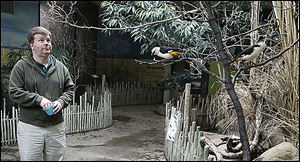
Aviary offers birders the rest of the world
5/4/2013
Robert Webster, Toledo Zoo curator of birds, watches White-Headed Buffalo Weavers inside the zoo's aviary.
As thousands of birding enthusiasts swarm over the northwest Ohio area to take advantage of the unparalleled viewing opportunities the spring migration presents, many have a checklist proudly in hand.
Part of the ritual for most birders is keeping a meticulous log. If you happen to catch an extended glimpse of a Blackburnian Warbler on its marathon journey from wintering grounds in the forests of South America to its nesting grounds in the northern Canadian wilderness, you make note of it.
Some of the bird-watchers who are filling hotels from Sandusky to Toledo have come a considerable distance as well, and they hope to depart with a lot of new checkmarks on their species list. If the migratory warblers cooperate and cluster in the marshes, meadows, and woodlots along the western Lake Erie shoreline to rest and feed before the long water crossing on their trip, the ink will pepper those checklists.
There are bonus points to be had, as well, if the birders get creative and consider all of their options. The Toledo Zoo and its aviary are home to 162 species, many of which the birding throng will not be able to see during the migration extravaganza, since these birds are from other corners of the globe.
That means a visit to the zoo could easily translate into bold checkmarks alongside such entries as the African pygmy goose, Kori bustard, Egyptian plover, Jambu fruit dove, Alexandrine parrot, and the Blue-faced honeyeater.
Robert Webster, the zoo’s curator of birds, is aware of the knowledgeable assembly that “The Biggest Week in American Birding” will bring to the region over its 10-day run, which started on Friday and continues through May 12.
“They can see a world of birds here in the Toledo area when they observe the migrating birds, but I also hope many of the birders will consider the zoo and the aviary as a wonderful option during their stay,” Webster said. “Here they can see other types of birds, and study their behavior and get a more close-up look.”
Webster said the aviary also affords birders the opportunity to familiarize themselves with the vocalization patterns of each species.
“We’ve had people come here before they made trips to Brazil or elsewhere, to learn about birds they might see, and really hone their skills,” he said.
“Birders are a unique audience, a very savvy audience — they know what they are looking at, and they have a real passion for what they are looking at. We hope they’ll find their way here, and we’re confident they’ll be impressed with what they see.”
The zoo aviary is a classic Works Progress Administration structure that opened in 1937, and then underwent an extensive renovation in 1998 that allowed it to maintain its architectural integrity. The exhibits were expanded and updated, free-flight walk-through sections were added, and skylights were placed to give the interior a soft, natural glow.
“The building really works, for the birds and for the guests,” Webster said. He added that the zoo grounds are also a fertile bird-watching territory during the spring migration period.
“We get a lot of birds coming through here, passing over, and using our tree canopy along the way.”
Whether the zoo and its aviary provide birders with a respite from the weather during a rain event, or just make up a single stop on a well-choreographed birding route they have mapped out for the “Biggest Week,” Richard Nachazel of Destination Toledo wants to see many birders take advantage of all of the options the region presents.
“Our goal is to help our visitors move around a bit, and while they are here we’d like them to take in our Metroparks, the art museum, our historical attractions, Imagination Station, and of course, the zoo,” he said.
Kim Kaufman, executive director of the Black Swamp Bird Observatory and one of the driving forces behind the “Biggest Week” festival, said that while the migrating birds are the primary drawing card for many of the visiting birders, the event has always trumpeted the area’s wide spectrum of assets.
“We have made it a point to always sell the region, and everything it has to offer,” she said. “It just makes so much sense to include many partners, because that way everyone benefits.”
Webster encourages visitors to the area to take in the full spectacle of the migratory warblers, and hopefully save time to spend in the aviary, which houses the fourth-largest collection of birds east of the Mississippi River.
“When you see the checklist, you know that’s a serious birder, but we feel that a visit to the aviary allows you to go beyond the checklist,” he said. “Here you are able to look at them, appreciate them, observe their behavior, and see what it is that makes that bird so exceptional.”
And while many of his charges are among the zoo’s smallest and least-threatening-looking residents, Webster believes their charm lies in their unique characteristics, not in massive size or brute strength.
“It’s hard to compete with a gorilla,” he said, “but that doesn’t mean our birds are any less charismatic.”
Contact Blade outdoors editor Matt Markey at: mmarkey@theblade.com or 419-724-6068.